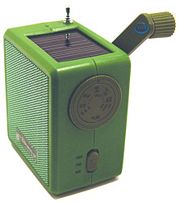Hand crank radio
From DDL Wiki
Contents |
Executive Summary
Stakeholders and Product Needs
Consumers
Retailers
Manufacturers
Shipping / Transport
Usage
How It is Used
User Studies
The portable hand-cranked radio seemed very easy to use. However, there were a few areas of design that must be changed. For instance, the resistance of the crank motion seems to be proportional to the speed of the cranking. The faster the cranking is, the more power is generated but the bigger the resistance becomes. There is a need to be able to find a balance point between resistance in the wheels and power generated from the crank and the solar panel.
While researching this product, there were a few common themes in the review of the product. They are as follow:
- Direct sunlight is needed for the panels to absorb sunlight efficiently
- Antenna for the radio goes straight up, it does not bend
- If you are using the product outside in a sunny day, you never have to crank for power as the solar panel itself will provide the radio with enough power
- On average, 1 minute of cranking gives approximately 15-25 minutes of playing time. Or, 100 turns of the crank is equal to approximate 10 minutes of audio
- The radio is small and light, it fits in the palm of your hand
From these comments, it can be concluded that the energy conversion either from mechanical to electrical, or from solar to electrical, is quite efficient. With a few tweaks, it may be possible to integrate this system with other daily life appliances to convert the rolling mechanical energy into electrical energy. A cheap and portable system to recapture the energy lost from a mechanical process in our daily life may present an interesting research and business opportunity. To achieve these goals for the design process, additional understanding and research on the product must be done.
Bill of Materials
Components
Assembly Diagram
Mechanical Function
Design for Manufacturing and Assembly (DFMA)
Failure Modes and Effects Analysis (FMEA)
Design for Environment (DFE)
Manufacturing
Use
End of Life
DFE Conclusions
Mechanical Analysis
Team Member Roles
References
Images taken from: Figure 1: www.amazon.com/Kikkerland-Dynamo-Solar-Crank-Emergency/dp/B0017S4C26/ref=sr_1_2?ie=UTF8&qid=1346370017&sr=8-2&keywords=

